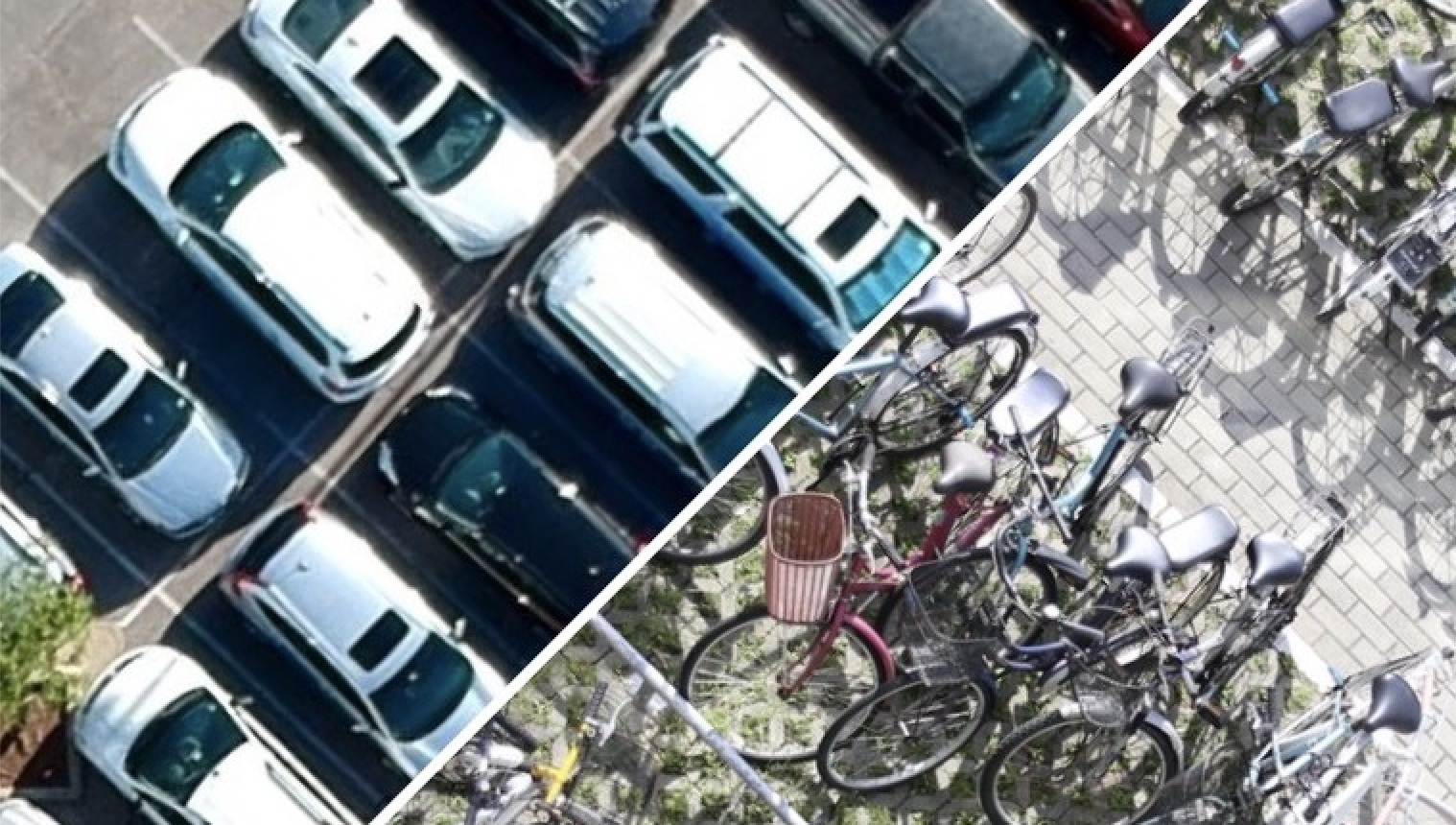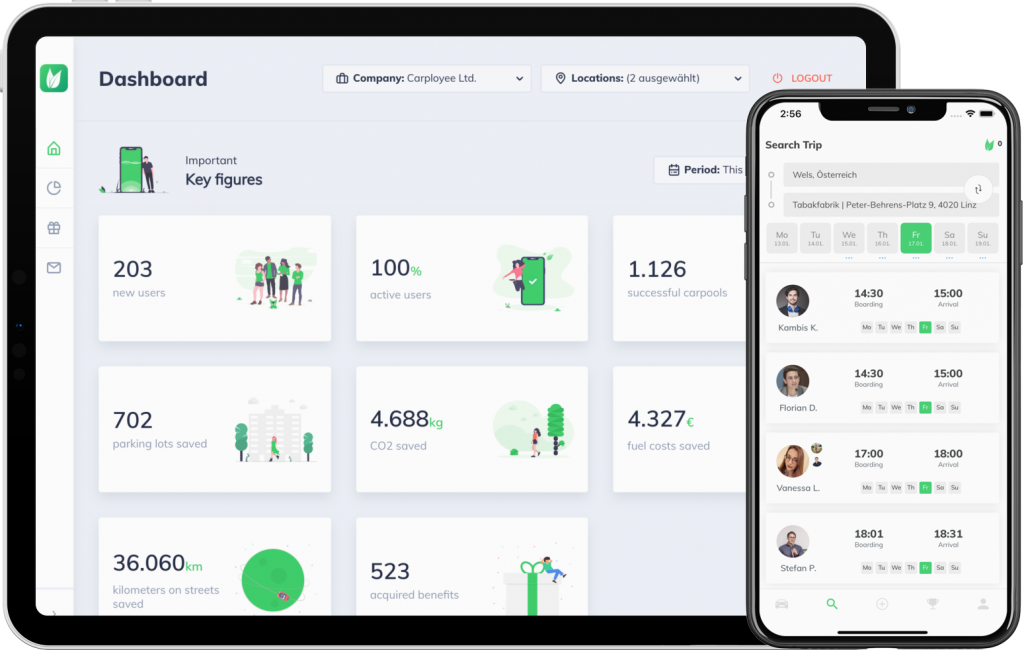In one of our last blog articles we talked about how the corona pandemic is the perfect launchpad for positive changes within your company. Sceptical? Read Corona as a kickstart for a corporate mobility concept here! At the end of the article we also touched upon company mobility management. We would like to dive deeper today and explain what concrete steps and measures you can take in your company to promote sustainable modes of transport for your employees. Each measure results in different benefits and should match the mobility concept as a whole. With our new UpScore Mobility Audit we help you to analyse the status quo of your company and choose the most promising measures.
Modes of corporate mobility
First of all, let’s distinguish a few modes of mobility. Each mode has its own characteristics and depending on whether you want to promote active mobility, e-mobility, shared use of cars or public transport, corresponding measures should be taken.
Active mobility
Active mobility includes anything powered by muscles: walking, cycling, skateboarding, theoretically even jumping. The advantages are crystal clear: Greenhouse gas emissions are close to zero (we have to take into account the emissions associated with the production of a bike, for example), an active and healthy lifestyle is promoted and traffic is reduced. But the disadvantages are equally obvious: Long distances cannot be covered, the weather has a big influence and certain minimal physical conditions are required. The aim should be to promote this type of mobility wherever and whenever possible, as long as it is reasonable. Especially the “first and last mile” is suitable for active mobility.
E-mobility
As far as e-mobility is concerned, despite the hype surrounding e-scooters, we are still at the very beginning – and the question whether such vehicles represent an advancement in sustainable mobility has not yet been conclusively clarified: How sustainable is the production, assembly and disposal of these scooters? Do we replace other modes of transport or do we rather add extra kilometers because riding e-scooters is fun? Precisely because e-mobility is still in its infancy – and because the mobility sector is known for innovative action – we can expect to see some changes in this area. Employers can take an important step in the right direction – for example by electrifying their own vehicle fleet or by offering their employees sharing concepts. The Austrian start-up Blitz has found a unique solution here. It provides companies with a pool of e-scooters including on-site service, predictable fixed costs and company branding. It has probably never been easier for employers to provide a comfortable means of transport for short distances that is also fun.
Cars
Could the ill-reputed car traffic tip the scales for more sustainable mobility? The answer is clearly: yes! Because it is not the car itself that harms our planet – it is how we use it. As long as many of us still take it for granted that we will be travelling alone in our cars on our daily journeys to and from work, emission figures will not drop significantly. It is time for a shift – and as an employer you can make a big contribution: Promote shared use of cars!
Public transport
We are living in fear of a pandemic and, consequently, the use and popularity of public transport is not necessarily at a record high. But this will change as soon as we can move among people again without the fear of infection. In the long term, the aim should be to promote the use of public transport – especially in urban companies.
Promoting sustainable corporate mobility: Lots of options, as long as you’re not on your own
There are various ways to promote each mode of mobility. It is important to get the workforce on board at the very beginning, and to respond to their needs. You should not put any pressure on the employees – after all, commuting is private time. Rather, you should make sustainable mobility appealing to them – and here are some examples of how that works out.
Organisational measures: Low-hanging fruits, if you’re a team
Make it as easy as possible for your employees to commute sustainably. This can be done, for example, by adapting working hours to public transport timetables or by implementing flexible work schedules. You can also adapt internal and external meetings to public transport – who knows, maybe one of your partners starts to adopt your policies. Promoting home office on a regular basis is another example: The commute doesn’t take place at all. Due to the Corona crisis you probably already know which departments qualify for regular home office. Organisational measures are often associated with low costs. Therefore, they represent low-hanging fruits on the transition to sustainable company mobility, as long as no internal barriers persist.
Incentives: Real rewards, not just unhealthy sweets or useless goodies
Sustainable mobility should not only be easy, but also rewarding – and the reward should come directly from the employer. So it is time to think about a reward system with meaningful incentives. Useless goodies that end up in the bin immediately do not qualify. A reward system can be easily implemented using the Carployee App, for example. A cycling campaign can also have a motivating effect – employees record the kilometres they have cycled using an app and receive rewards thereafter. Another idea: the introduction of parking fees, which are paid back by the employer via discounts on public transport tickets. The Projekt rk GmbH mainly relied on incentive measures in its company mobility concept – among other things there were annual one-off payments to employees with particularly sustainable mobility behaviour and a carpooling scheme. Additionally, carsharing was introduced to cover peaks in demand. With these measures the company achieved an annual CO2 savings of 20 t!
Infrastructural measures: Now it’s getting serious
Your employees may have been willing to switch to a sustainable commute for a long time – but they simply didn’t have the right infrastructure or vehicle fleet yet. An employee survey could show that the workforce would welcome infrastructural measures such as an e-charging station or electric company cars. The possibility of carsharing is also often gladly accepted – especially if the cars may also be used for private purposes. Sometimes positive change can require even a comparatively small deed – setting up a small bicycle parking lot near the building entrance or a staff shower for refreshment after a sweaty bicycle ride. Infrastructural measures might require a considerable financial investment. A serious matter, therefore, but one that is rewarded by employees and the public alike. In case of doubt, have a look at the long-term cost savings. The IHK Darmstadt Rhein Main Neckar relied on a mix of mainly infrastructural measures: They introduced a modern parking management system, set up an employee shower, optimised travel information for visitors and financed a job ticket for public transport. The result: Motorised individual transport decreased by 40%, the share of cyclists grew by 7% and the use of public transport increased by a whole 20%.
Info material, activities and campaigns: Attract attention!
Raise awareness of sustainable corporate mobility with special actions and campaigns. This can be quite simple – in the form of information material that is distributed throughout the company building. But your team can also be creative – bicycle competitions, folding bike test campaigns, quizzes with a prize, a company-wide e-mobility day or public transport day. There are no limits to your imagination, the only thing to consider is to arouse the interest of your staff without too much pressure. Sympathex Technologies GmbH has developed its own mobility concept based on a comprehensive analysis. An important part of this was the campaign “Cycle to work”, in which participants must cycle to work on at least 20 days between April and September in order to participate in a raffle with attractive prizes. In addition, carpooling was encouraged, long-distance journeys were optimised and eco-taxis were offered for repetitive journeys. This resulted in CO2 savings of 95.3 t per year. The case studies were taken from the guide for corporate mobility management of the German SME initiative for energy transition and climate protection.
Corporate mobility management – now it’s your turn!
We hope we gave you an impression of what company mobility management looks like and how employers can contribute to sustainable mobility and climate protection. In the next article we will look at the infamous modal split and show you why even small changes can have a big positive impact on employee mobility and the environment.
Credits: Cover image by jje10tw from Pixabay and Lucas Hobbs on Unsplash









